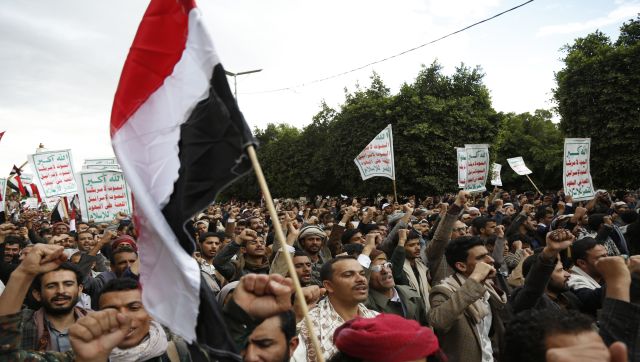The Houthi movement in Yemen fired down a US drone on Wednesday night, more than a week after formally declaring war on Israel. This has sparking worries of a regional escalation. Yemen’s Houthi commander vowed on Tuesday that his forces would continue to assault Israel, possibly targeting Israeli ships in the Red Sea and the Bab al-Mandeb Strait. The action by the Iran-linked militia, which controls wide areas of Yemen, comes as Israel continues to attack Gaza, killing over 10,500 Palestinians, including over 4,300 children. For years, the Houthi rebels controlling northern Yemen have chanted slogans at their mass rallies calling for the destruction of Israel. But they never acted on it until the Israel-Hamas war began on 7 October. Since then, the Iran-backed Shiite Muslim force has launched at least six drone and missile attacks toward southern Israel, causing little to no damage. Most have been intercepted by
Israeli air defences on their journey of over 1,600 kilometres (960 miles) from northern Yemen. The Houthis said the barrage is in retaliation for the Israeli army’s bombardment of Gaza and will continue until “Israeli aggression stops.” Here’s a look at the attacks and what threat they pose. Who are the rebels who seized Sanaa? In 2014, the Houthis swept from their stronghold in Yemen’s northern mountains and seized the capital, Sanaa, along with other central areas of the country. The Islamist group follows the Shiite Zaydi faith, a branch of Shiite Islam almost exclusively found in northwest Yemen. The majority of Yemen’s population are Sunni Muslim, but Zaydis make up a large minority. The Houthi movement was fuelled by decades of marginalisation by Yemen’s ruling elite. [caption id=“attachment_13392122” align=“alignnone” width=“640”] For years, the Houthi rebels controlling northern Yemen have chanted slogans at their mass rallies calling for the destruction of Israel. But they never joined any conflict beyond the confines of their own country’s civil war or nearby in the Arabian Peninsula. File image/AP[/caption] Their takeover sparked a brutal civil war. Saudi Arabia and its allies formed a military coalition to back the government that was driven out of Sanaa to the south. Yemen became another front in the regional rivalry between Saudi Arabia and Iran. The war has killed more than 150,000 people and created one of the world’s worst humanitarian disasters. The Houthi movement espouses a hard-line Islamist ideology. Over time, it has hardened its anti-American, anti-Saudi and anti-Israeli rhetoric. Their official slogan reads “God is the greatest, death to America, death to Israel. Curse the Jews, victory to Islam.” Why attack Israel? The attacks are a public show of support for Hamas, which is also backed by Iran, but also a reflection of the Houthis’ doctrine and ambitions. They join their allies in the “Axis of Resistance,” a collection of Iran-backed groups and governments in the region. Other key members, Hamas and Hezbollah, have kept up a steady fire on Israel since the war began.
**Also Read: Babies dying, bodies rotting: Inside Gaza’s largest hospital which has stopped functioning** Two Houthi officials said the group’s leadership is in communication with Hezbollah and Hamas about their military activities but not the Iranian government. The officials refused to elaborate and spoke on condition of anonymity as they were not authorised to speak with the media. The Houthis’ anti-Western sentiment is a driver in itself, said Farea al-Muslimi, a research fellow at Chatham House specialising in Yemen. “Their ‘death to America, death to Israel’ slogan is not there for electoral and voter reasons,” al-Muslimi said. “It is a life and ideology doctrine.” Unlike Hezbollah and Hamas, whose fighters border Israel, distance makes Houthi attacks much harder. Given this, al-Muslimi said he expects the low-level drone and missile fire to continue but not intensify greatly. [caption id=“attachment_13392132” align=“alignnone” width=“640”]
The Houthis said the barrage is in retaliation for the Israeli army’s bombardment of Gaza and will continue until “Israeli aggression stops.” File image/AP[/caption] “They will hit Israel just enough to say, ‘We can hit you too,’” he said, There are other ways the conflict could escalate. Abdul Malik al-Houthi, the group’s supreme leader, said Tuesday his forces would target Israeli ships operating in the Red Sea. Last week, the Houthis downed a US drone it said was flying above Yemeni territorial waters and spying on its forces. The US State Department acknowledged the attack. The Houthi leader has warned of strikes on American interests in the region if Washington becomes directly involved in the Israel-Hamas conflict.
**Also Read: Why Gaza civilians are holding white flags as they flee Israeli assault** The Houthi attacks are likely to further complicate their peace talks with the Saudi government, which have gone on for months as neither side is able to achieve victory on the battlefield. The strikes on Israel “will only further embolden the Houthis and the belief they have the upper hand” against the Saudi coalition, said Nadwa Dawsari, a non-resident scholar at the Middle East Institute. She points out that renewed clashes have flared along the front lines in Yemen, including in the contested city of Marib and along the northern border. What are the Houthis’ military capabilities? The Houthis’ arsenal has grown in size and variety since 2014. Analysts and Western intelligence services accuse Iran of arming the group. Tehran denies this. In recent years, US naval forces have intercepted a number of ships packed with rifles, rocket-propelled grenades and missile parts on route from Iran to Houthi-controlled areas of Yemen.
**Also Read: Is Hamas using Gaza hospitals to carry out terror operations?** The Houthis have long-range ballistic missiles, smaller cruise missiles and suicide drones, all capable of reaching southern Israel, weapons experts say. The Houthis are far more open about their arsenal than Hamas and Hezbollah, displaying new ballistic missiles such as the “Tofun” during military parades. The depth of their arsenal is less known. The Houthis say they have fired drones and ballistic missiles at southern Israel. In thwarting attacks from the Red Sea, Israel said it used its Arrow missile defence system, which intercepts long-range ballistic missiles. Fabian Hinz, a missile expert and research fellow at the International Institute for Strategic Studies, said the only way to overcome Israeli defence systems would be to overwhelm them with large numbers of missiles, “and you cannot really do that over 1,600 kilometres.” Attacks on closer targets and shipping would be more effective, he said. There no clear examples of effective long-range Houthi strikes. In 2019, cruise missiles and drones struck the centre of Saudi Arabia’s oil industry in Abqaiq, about 1,000 kilometres (600 miles) from northern Yemen. The attack temporarily halved the kingdom’s production and spiked global energy prices. While the Houthis claimed the attack, a United Nations investigation concluded it was too sophisticated to have been carried out by the rebels. Washington later said it was launched from Iran. With inputs from AP
The Iran-backed Shiite Muslim force has launched at least six drone and missile attacks toward southern Israel, causing little to no damage. The Houthis said the barrage is in retaliation for the Israeli army’s bombardment of Gaza and will continue until ‘Israeli aggression stops’
Advertisement
End of Article


)

)
)
)
)
)
)
)
)



